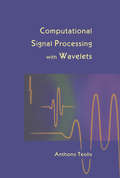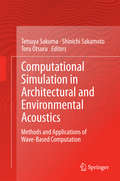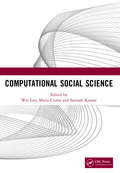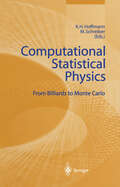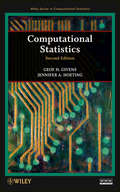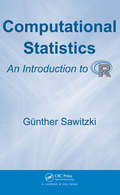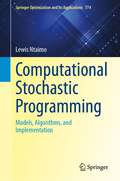- Table View
- List View
Computational Signal Processing with Wavelets (Applied and Numerical Harmonic Analysis)
by Anthony TeolisOverview For over a decade now, wavelets have been and continue to be an evolving subject of intense interest. Their allure in signal processing is due to many factors, not the least of which is that they offer an intuitively satisfying view of signals as being composed of little pieces of wa'ues. Making this concept mathematically precise has resulted in a deep and sophisticated wavelet theory that has seemingly limitless applications. This book and its supplementary hands-on electronic: component are meant to appeal to both students and professionals. Mathematics and en gineering students at the undergraduate and graduate levels will benefit greatly from the introductory treatment of the subject. Professionals and advanced students will find the overcomplete approach to signal represen tation and processing of great value. In all cases the electronic component of the proposed work greatly enhances its appeal by providing interactive numerical illustrations. A main goal is to provide a bridge between the theory and practice of wavelet-based signal processing. Intended to give the reader a balanced look at the subject, this book emphasizes both theoretical and practical issues of wavelet processing. A great deal of exposition is given in the beginning chapters and is meant to give the reader a firm understanding of the basics of the discrete and continuous wavelet transforms and their relationship. Later chapters promote the idea that overcomplete systems of wavelets are a rich and largely unexplored area that have demonstrable benefits to offer in many applications.
Computational Simulation in Architectural and Environmental Acoustics: Methods and Applications of Wave-Based Computation
by Tetsuya Sakuma Shinichi Sakamoto Toru OtsuruThis book reviews a variety of methods for wave-based acoustic simulation and recent applications to architectural and environmental acoustic problems.Following an introduction providing an overview of computational simulation of sound environment, the book is in two parts: four chapters on methods and four chapters on applications. The first part explains the fundamentals and advanced techniques for three popular methods, namely, the finite-difference time-domain method, the finite element method, and the boundary element method, as well as alternative time-domain methods. The second part demonstrates various applications to room acoustics simulation, noise propagation simulation, acoustic property simulation for building components, and auralization.This book is a valuable reference that covers the state of the art in computational simulation for architectural and environmental acoustics.
Computational Single-Electronics (Computational Microelectronics)
by Christoph WasshuberSingle-electronics is a fascinating technology which reveals new physical effects of charge transport. It has many benefits and great figure of merits but also several open challenges waiting for elegant solutions . In my almost o- decade-long involvement in single-electronics I have seen a steady rise in interest measurable in the number of published articles, conference talks, and research grants from government and industry . In order to collect , categorize, and summarize a good part of this body of knowledge as well as to introduce some new points of view, variations , and extensions, I set out to write this book. A book targeted at the student eager to delve into single-electronics as well as the expert who needs a reference for theory, circuits, and algorithms for system analyses. This book addresses three areas : the theory which goes beyond the orthodox theory, the computational methods necessary to analyze sing- electron circuits, and applications and manufacturing methods, the practical side of single-electronics. The theory was kept short and concise, suitable for people seeking a compact introduction or reference . For in-depth coverage one has to consult cited articles and books. The computational part is very complete and can be considered state of the art for single-electronics . Almost all algorithms which are necessary for a successful and efficient implemen- tion are stated . Not all of them are exhaustively explained but at least a recipe for their successful implementation is given .
Computational Social Science: Proceedings of the 1st International Conference on New Computational Social Science (ICNCSS 2020), September 25-27, 2020, Guangzhou, China
by Wei LuoSelected papers from the International Conference on New Computational Social Science, focusing on the following five aspects: Big data acquisition and analysis, Integration of qualitative research and quantitative research, Sociological Internet experiment research, Application of ABM simulation method in Sociology Research, Research and development of new social computing tools. With the rapid development of information technology, especially sweeping progress in the Internet of things, cloud computing, social networks, social media and big data, social computing, as a data-intensive science, is an emerging field that leverages the capacity to collect and analyze data with an unprecedented breadth, depth and scale. It represents a new computing paradigm and an interdisciplinary field of research and application. A broad comprehension of major topics involved in social computing is important for both scholars and practitioners. This proceedings presents and discusses key concepts and analyzes the state-of-the-art of the field. The conference not only gave insights on social computing, but also affords conduit for future research in the field. Social computing has two distinct trends: One is on the social science issues, such as computational social science, computational sociology, social network analysis, etc; The other is on the use of computational techniques. Finally some new challenges ahead are summarized, including interdisciplinary cooperation and training, big data sharing for scientific data mashups, and privacy protect.
Computational Social Science: Proceedings of the 1st International Conference on New Computational Social Science (ICNCSS 2020), September 25-27, 2020, Guangzhou, China
by Wei Luo Maria Ciurea Santosh KumarSelected papers from the International Conference on New Computational Social Science, focusing on the following five aspects: Big data acquisition and analysis, Integration of qualitative research and quantitative research, Sociological Internet experiment research, Application of ABM simulation method in Sociology Research, Research and development of new social computing tools. With the rapid development of information technology, especially sweeping progress in the Internet of things, cloud computing, social networks, social media and big data, social computing, as a data-intensive science, is an emerging field that leverages the capacity to collect and analyze data with an unprecedented breadth, depth and scale. It represents a new computing paradigm and an interdisciplinary field of research and application. A broad comprehension of major topics involved in social computing is important for both scholars and practitioners. This proceedings presents and discusses key concepts and analyzes the state-of-the-art of the field. The conference not only gave insights on social computing, but also affords conduit for future research in the field. Social computing has two distinct trends: One is on the social science issues, such as computational social science, computational sociology, social network analysis, etc; The other is on the use of computational techniques. Finally some new challenges ahead are summarized, including interdisciplinary cooperation and training, big data sharing for scientific data mashups, and privacy protect.
Computational Solution of Large-Scale Macroeconometric Models (Advances in Computational Economics #7)
by Giorgio PaulettoThis book is the result of my doctoral dissertation research at the Department of Econometrics of the University of Geneva, Switzerland. This research was also partially financed by the Swiss National Science Foundation (grants 12- 31072.91 and 12-40300.94). First and foremost, I wish to express my deepest gratitude to Professor Manfred Gilli, my thesis supervisor, for his constant support and help. I would also like to thank the president of my jury, Professor Fabrizio Carlevaro, as well as the other members of the jury, Professor Andrew Hughes Hallett, Professor Jean-Philippe Vial and Professor Gerhard Wanner. I am grateful to my colleagues and friends of the Departement of Econometrics, especially David Miceli who provided constant help and kind understanding during all the stages of my research. I would also like to thank Pascale Mignon for proofreading my text and im proving my English. Finally, I am greatly indebted to my parents for their kindness and encourage ments without which I could never have achieved my goals. Giorgio Pauletto Department of Econometrics, University of Geneva, Geneva, Switzerland Chapter 1 Introduction The purpose of this book is to present the available methodologies for the solution of large-scale macroeconometric models. This work reviews classical solution methods and introduces more recent techniques, such as parallel com puting and nonstationary iterative algorithms.
Computational Statistical Methodologies and Modeling for Artificial Intelligence (ISSN)
by Priyanka Harjule Azizur Rahman Basant Agarwal Vinita TiwariThis book covers computational statistics-based approaches for Artificial Intelligence. The aim of this book is to provide comprehensive coverage of the fundamentals through the applications of the different kinds of mathematical modelling and statistical techniques and describing their applications in different Artificial Intelligence systems. The primary users of this book will include researchers, academicians, postgraduate students, and specialists in the areas of data science, mathematical modelling, and Artificial Intelligence. It will also serve as a valuable resource for many others in the fields of electrical, computer, and optical engineering.The key features of this book are: Presents development of several real-world problem applications and experimental research in the field of computational statistics and mathematical modelling for Artificial Intelligence Examines the evolution of fundamental research into industrialized research and the transformation of applied investigation into real-time applications Examines the applications involving analytical and statistical solutions, and provides foundational and advanced concepts for beginners and industry professionals Provides a dynamic perspective to the concept of computational statistics for analysis of data and applications in intelligent systems with an objective of ensuring sustainability issues for ease of different stakeholders in various fields Integrates recent methodologies and challenges by employing mathematical modeling and statistical techniques for Artificial Intelligence
Computational Statistical Methodologies and Modeling for Artificial Intelligence (ISSN)
by Priyanka Harjule Azizur Rahman Basant Agarwal Vinita TiwariThis book covers computational statistics-based approaches for Artificial Intelligence. The aim of this book is to provide comprehensive coverage of the fundamentals through the applications of the different kinds of mathematical modelling and statistical techniques and describing their applications in different Artificial Intelligence systems. The primary users of this book will include researchers, academicians, postgraduate students, and specialists in the areas of data science, mathematical modelling, and Artificial Intelligence. It will also serve as a valuable resource for many others in the fields of electrical, computer, and optical engineering.The key features of this book are: Presents development of several real-world problem applications and experimental research in the field of computational statistics and mathematical modelling for Artificial Intelligence Examines the evolution of fundamental research into industrialized research and the transformation of applied investigation into real-time applications Examines the applications involving analytical and statistical solutions, and provides foundational and advanced concepts for beginners and industry professionals Provides a dynamic perspective to the concept of computational statistics for analysis of data and applications in intelligent systems with an objective of ensuring sustainability issues for ease of different stakeholders in various fields Integrates recent methodologies and challenges by employing mathematical modeling and statistical techniques for Artificial Intelligence
Computational Statistical Physics: From Billiards to Monte Carlo
by K. H Hoffmann Michael SchreiberIn recent years statistical physics has made significant progress as a result of advances in numerical techniques. While good textbooks exist on the general aspects of statistical physics, the numerical methods and the new developments based on large-scale computing are not usually adequately presented. In this book 16 experts describe the application of methods of statistical physics to various areas in physics such as disordered materials, quasicrystals, semiconductors, and also to other areas beyond physics, such as financial markets, game theory, evolution, and traffic planning, in which statistical physics has recently become significant. In this way the universality of the underlying concepts and methods such as fractals, random matrix theory, time series, neural networks, evolutionary algorithms, becomes clear. The topics are covered by introductory, tutorial presentations.
Computational Statistics: Volume 1: Proceedings of the 10th Symposium on Computational Statistics
by Yadolah Dodge Joe WhittakerThe Role of the Computer in Statistics David Cox Nuffield College, Oxford OXIINF, U.K. A classification of statistical problems via their computational demands hinges on four components (I) the amount and complexity of the data, (il) the specificity of the objectives of the analysis, (iii) the broad aspects of the approach to analysis, (ill) the conceptual, mathematical and numerical analytic complexity of the methods. Computational requi rements may be limiting in (I) and (ill), either through the need for special programming effort, or because of the difficulties of initial data management or because of the load of detailed analysis. The implications of modern computational developments for statistical work can be illustrated in the context of the study of specific probabilistic models, the development of general statistical theory, the design of investigations and the analysis of empirical data. While simulation is usually likely to be the most sensible way of investigating specific complex stochastic models, computerized algebra has an obvious role in the more analyti cal work. It seems likely that statistics and applied probability have made insufficient use of developments in numerical analysis associated more with classical applied mathematics, in particular in the solution of large systems of ordinary and partial differential equations, integral equations and integra-differential equations and for the ¢raction of "useful" in formation from integral transforms. Increasing emphasis on models incorporating specific subject-matter considerations is one route to bridging the gap between statistical ana.
Computational Statistics: Volume 2: Proceedings of the 10th Symposium on Computational Statistics, COMPSTAT, Neuchâtel, Switzerland, August 1992
by Yadolah Dodge Joe WhittakerThe papers assembled in this book were presented at the biannual symposium of Inter national Association for Statistical Computing in Neuchcitel, Switzerland, in August of 1992. This congress marked the tenth such meeting from its inception in 1974 at Vienna and maintained the tradition of providing a forum for the open discussion of progress made in computer oriented statistics and the dissemination of new ideas throughout the statistical community. It was gratifying to see how well the groups of theoretical statisti cians, software developers and applied research workers were represented, whose mixing is an event made uniquely possible by this symposium. While maintaining traditions certain new features have been introduced at this con ference: there were a larger number of invited speakers; there was more commercial sponsorship and exhibition space; and a larger body of proceedings have been published. The structure of the proceedings follows a standard format: the papers have been grouped together according to a rough subject matter classification, and within topic follow an approximate aphabetical order. The papers are published in two volumes ac cording to the emphasis of the topics: volume I gives a slight leaning towards statistics and modelling, while volume II is focussed more on computation; but this is certainly only a crude distinction and the volumes have to be thought of as the result of a single en terprise.
Computational Statistics (Statistics and Computing)
by James E. GentleComputational inference is based on an approach to statistical methods that uses modern computational power to simulate distributional properties of estimators and test statistics. This book describes computationally intensive statistical methods in a unified presentation, emphasizing techniques, such as the PDF decomposition, that arise in a wide range of methods.
Computational Statistics (Wiley Series in Computational Statistics #710)
by Geof H. Givens Jennifer A. HoetingThis new edition continues to serve as a comprehensive guide to modern and classical methods of statistical computing. The book is comprised of four main parts spanning the field: Optimization Integration and Simulation Bootstrapping Density Estimation and Smoothing Within these sections,each chapter includes a comprehensive introduction and step-by-step implementation summaries to accompany the explanations of key methods. The new edition includes updated coverage and existing topics as well as new topics such as adaptive MCMC and bootstrapping for correlated data. The book website now includes comprehensive R code for the entire book. There are extensive exercises, real examples, and helpful insights about how to use the methods in practice.
Computational Statistics (Wiley Series in Computational Statistics #708)
by Geof H. Givens Jennifer A. HoetingThis new edition continues to serve as a comprehensive guide to modern and classical methods of statistical computing. The book is comprised of four main parts spanning the field: Optimization Integration and Simulation Bootstrapping Density Estimation and Smoothing Within these sections,each chapter includes a comprehensive introduction and step-by-step implementation summaries to accompany the explanations of key methods. The new edition includes updated coverage and existing topics as well as new topics such as adaptive MCMC and bootstrapping for correlated data. The book website now includes comprehensive R code for the entire book. There are extensive exercises, real examples, and helpful insights about how to use the methods in practice.
Computational Statistics: An Introduction to R
by G�nther SawitzkiSuitable for a compact course or self-study, Computational Statistics: An Introduction to R illustrates how to use the freely available R software package for data analysis, statistical programming, and graphics. Integrating R code and examples throughout, the text only requires basic knowledge of statistics and computing.This introduction covers o
Computational Statistics and Data Intelligence: APCAMS 2023, Chongqing, China, June 24–26 (Springer Proceedings in Mathematics & Statistics #463)
by Hari M. Srivastava Wenfeng Wang Wanyang DaiThis book gathers selected papers presented at the Asia-Pacific Conference on Applied Mathematics and Statistics held on June 24–26, 2023, in Chongqing, China. It presents the most recent research and advances in various areas of applied mathematics and statistics, span from mathematical theory, calculation, modeling, simulation, to applications such as big data and image processing.
Computational Statistics Handbook with MATLAB
by Wendy L. Martinez Angel R. MartinezAs with the bestselling first edition, Computational Statistics Handbook with MATLAB, Second Edition covers some of the most commonly used contemporary techniques in computational statistics. With a strong, practical focus on implementing the methods, the authors include algorithmic descriptions of the procedures as well as
Computational Statistics Handbook with MATLAB (Chapman And Hall/crc Computer Science And Data Analysis Ser.)
by Wendy L. Martinez Angel R. MartinezA Strong Practical Focus on Applications and AlgorithmsComputational Statistics Handbook with MATLAB, Third Edition covers today's most commonly used techniques in computational statistics while maintaining the same philosophy and writing style of the bestselling previous editions. The text keeps theoretical concepts to a minimum, emphasizing the i
Computational Statistics in Data Science
by Walter W. Piegorsch Richard A. Levine Hao Helen Zhang Thomas C. M. LeeAn essential roadmap to the application of computational statistics in contemporary data science In Computational Statistics in Data Science, a team of distinguished mathematicians and statisticians delivers an expert compilation of concepts, theories, techniques, and practices in computational statistics for readers who seek a single, standalone sourcebook on statistics in contemporary data science. The book contains multiple sections devoted to key, specific areas in computational statistics, offering modern and accessible presentations of up-to-date techniques. Computational Statistics in Data Science provides complimentary access to finalized entries in the Wiley StatsRef: Statistics Reference Online compendium. Readers will also find: A thorough introduction to computational statistics relevant and accessible to practitioners and researchers in a variety of data-intensive areas Comprehensive explorations of active topics in statistics, including big data, data stream processing, quantitative visualization, and deep learningPerfect for researchers and scholars working in any field requiring intermediate and advanced computational statistics techniques, Computational Statistics in Data Science will also earn a place in the libraries of scholars researching and developing computational data-scientific technologies and statistical graphics.
Computational Statistics in Data Science
by Walter W. Piegorsch Richard F. Levine Hao Helen Zhang Thomas C. M. LeeAn essential roadmap to the application of computational statistics in contemporary data science In Computational Statistics in Data Science, a team of distinguished mathematicians and statisticians delivers an expert compilation of concepts, theories, techniques, and practices in computational statistics for readers who seek a single, standalone sourcebook on statistics in contemporary data science. The book contains multiple sections devoted to key, specific areas in computational statistics, offering modern and accessible presentations of up-to-date techniques. Computational Statistics in Data Science provides complimentary access to finalized entries in the Wiley StatsRef: Statistics Reference Online compendium. Readers will also find: A thorough introduction to computational statistics relevant and accessible to practitioners and researchers in a variety of data-intensive areas Comprehensive explorations of active topics in statistics, including big data, data stream processing, quantitative visualization, and deep learningPerfect for researchers and scholars working in any field requiring intermediate and advanced computational statistics techniques, Computational Statistics in Data Science will also earn a place in the libraries of scholars researching and developing computational data-scientific technologies and statistical graphics.
Computational Stochastic Programming: Models, Algorithms, and Implementation (Springer Optimization and Its Applications #774)
by Lewis NtaimoThis book provides a foundation in stochastic, linear, and mixed-integer programming algorithms with a focus on practical computer algorithm implementation. The purpose of this book is to provide a foundational and thorough treatment of the subject with a focus on models and algorithms and their computer implementation. The book’s most important features include a focus on both risk-neutral and risk-averse models, a variety of real-life example applications of stochastic programming, decomposition algorithms, detailed illustrative numerical examples of the models and algorithms, and an emphasis on computational experimentation. With a focus on both theory and implementation of the models and algorithms for solving practical optimization problems, this monograph is suitable for readers with fundamental knowledge of linear programming, elementary analysis, probability and statistics, and some computer programming background. Several examples of stochastic programming applications areincluded, providing numerical examples to illustrate the models and algorithms for both stochastic linear and mixed-integer programming, and showing the reader how to implement the models and algorithms using computer software.
Computational Structural Analysis and Finite Element Methods
by A. KavehGraph theory gained initial prominence in science and engineering through its strong links with matrix algebra and computer science. Moreover, the structure of the mathematics is well suited to that of engineering problems in analysis and design. The methods of analysis in this book employ matrix algebra, graph theory and meta-heuristic algorithms, which are ideally suited for modern computational mechanics. Efficient methods are presented that lead to highly sparse and banded structural matrices. The main features of the book include: application of graph theory for efficient analysis; extension of the force method to finite element analysis; application of meta-heuristic algorithms to ordering and decomposition (sparse matrix technology); efficient use of symmetry and regularity in the force method; and simultaneous analysis and design of structures.
The Computational Structure of Life Cycle Assessment (Eco-Efficiency in Industry and Science #11)
by R. Heijungs Sangwon SuhLife Cycle assessment (LCA) is a tool for environmental decision-support in relation to products from the cradle to the grave. Until now, more emphasis has been put on the inclusion quantitative models and databases and on the design of guidebooks for applying LCA than on the integrative aspect of combining these models and data. This is a remarkable thing, since LCA in practice deals with thousands of quantitative data items that have to be combined in the correct manner. For this, one needs mathematical rules and algorithmic principles for carrying out an LCA. This book presents the first coherent treatment of the mathematical and algorithmic aspects of LCA. These computational aspects are presented in matrix form, so that a concise and elegant formulation is achieved. This form, moreover, provides a platform for further extension of analysis using perturbation theory, structural theory and economic input-output analysis.
Computational Surface and Roundness Metrology
by Balasubramanian Muralikrishnan Jayaraman Raja“Computational Surface and Roundness Metrology” provides an extraordinarily practical and hands-on approach towards understanding the diverse array of mathematical methods used in surface texture and roundness analysis. The book, in combination with a mathematical package or programming language interface, provides an invaluable tool for experimenting, learning, and discovering the many flavors of mathematics that are so routinely taken for granted in metrology. Whether the objective is to understand the origin of that ubiquitous transmission characteristics curve of a filter we see so often yet do not quite comprehend, or to delve into the intricate depths of a deceptively simple problem of fitting a line or a plane to a set of points, this book describes it all (in exhaustive detail). From the graduate student of metrology to the practicing engineer on the shop floor, this book is a must-have reference for all involved in metrology, instrumentation/optics, manufacturing, and electronics.
Computational Synthetic Geometry (Lecture Notes in Mathematics #1355)
by Jürgen Bokowski Bernd SturmfelsComputational synthetic geometry deals with methods for realizing abstract geometric objects in concrete vector spaces. This research monograph considers a large class of problems from convexity and discrete geometry including constructing convex polytopes from simplicial complexes, vector geometries from incidence structures and hyperplane arrangements from oriented matroids. It turns out that algorithms for these constructions exist if and only if arbitrary polynomial equations are decidable with respect to the underlying field. Besides such complexity theorems a variety of symbolic algorithms are discussed, and the methods are applied to obtain new mathematical results on convex polytopes, projective configurations and the combinatorics of Grassmann varieties. Finally algebraic varieties characterizing matroids and oriented matroids are introduced providing a new basis for applying computer algebra methods in this field. The necessary background knowledge is reviewed briefly. The text is accessible to students with graduate level background in mathematics, and will serve professional geometers and computer scientists as an introduction and motivation for further research.
